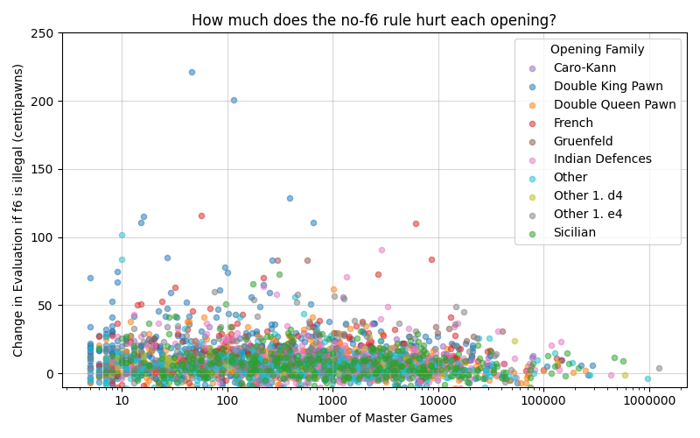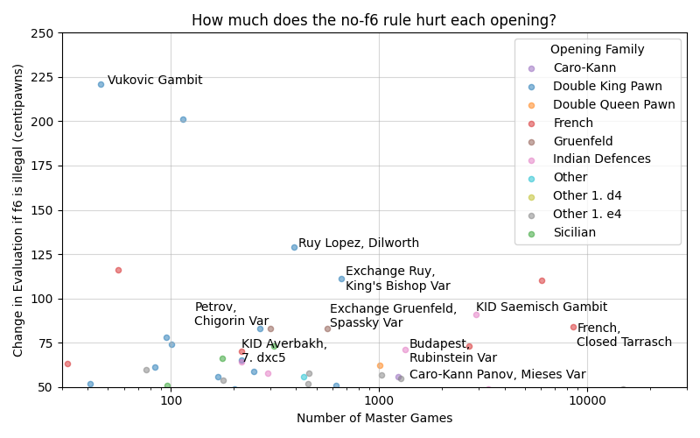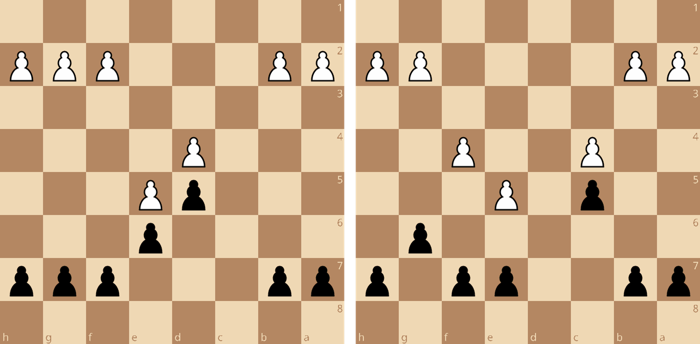Grandmaster Ben Finegold has some thoughts on how you ought to play chess.
In videos and lectures Ben shares nuggets of advice which he calls his rules, including the rule never play f6. The rules are generally helpful - f6 does often weaken your king - but of course they aren’t right for every position and are sometimes downright silly. Never play f6 is an overly-broad tongue-in-cheek suggestion, not a rule.
But what if it was?
In this post we’ll build a world where f6 is forbidden, and we’ll see what types of openings just don’t work anymore. Ultimately this constraint will teach us about the many ways in which f6 can help our position. Let’s dive in.
Here’s the plan:
- Modify the Stockfish engine to treat f6 as an illegal move [^1]. We’ll call it FinegoldFish
- Evaluate a named openings in the Encyclopedia of Chess Openings (ECO) with both FinegoldFish and Stockfish
- Find some openings that are both a) popular, and b) evaluated much more negatively for black by Finegoldfish than Stockfish
- Play through some games to determine why f6 is such an important resource in those lines
Opening DB Analysis
The figure below shows ~2000 dots, each one representing a named position in the ECO. The horizontal axis shows popularity in master play (using the Lichess Database), and the vertical axis shows FinegoldFish_Evaluation - Stockfish_Evaluation[^2], measured in centipawns (where 100 centipawns = 1 pawn). Openings further to the right are more popular, and openings higher on the graph are more heavily punished by Ben’s rule.

Most openings are not affected by Ben's rule, but not all of them
The vast majority of openings have little to no difference, and that makes sense. For example, in the Dutch after 1. d4 f5, f6 is never a legal move for black so the Finegold rule is totally irrelevant. Even lines where f6 is one of black’s main plans won’t be affected - black just needs some decent alternate plan that don’t involve f6. Despite this, the graph shows some openings become up to two pawns worse if f6 is forbidden. That’s a huge shift! Let’s zoom in on the top of the graph to see what they are.

Zooming in on the popular openings most harmed by the no-f6 rule
I’ve labeled a few of the openings. If you’re curious about where your favourite line falls on this graph you can search for it in the full results spreadsheet here: ECO Openings Analyzed.
So far we know a few things about the no-f6 rule:
- Most openings aren’t too badly affected
- Some openings take a big hit, losing over a pawn’s worth of eval
- Many of the badly hurt openings are in 1. e4, particularly 1.e4 e5
What we don’t know is why. What is it about the Vukovic Gambit that stinks so much if black can’t play f6? To answer this we can play out some of those punished positions with the help of Stockfish, FinegoldFish, and the master’s database.
Opening Analysis: Reasons You Might Need to Play f6
I selected ten openings that are both popular and punished by the no-f6 rule and created a study to explore why: Study - Never Play f6??. In each line the move f6 is a key resource for black, but for different reasons. I’ve grouped the games according to f6’s purpose, and we’ll look at an example of each below. We won’t necessarily follow the top engine moves (they’re given in variations) but instead follow the natural course of play that best highlights the importance of f6.
Tactical Necessity - Vukovic Gambit
Probably the most convincing and least interesting examples of the lot, sometimes f6 is simply the only move to prevent immediate material loss. Being able to repel a white bishop after it moves to g5 seems to be particularly thematic.
Other examples:
- Exchange Ruy Lopez, King’s Bishop Variation
- Caro-Kann Panov, Mieses Variation
- Petrov, Classical Chigorin
Contest The White Pawn Center - French Tarrasch
A more familiar reason for f6 comes from closed French structures, which I get a lot as a lover of the Caro-Kann and French. Typically in these positions Black can’t hope to play around white’s center and instead must attack it. It’s most common to attack the base of the pawn chain with c5, but attacking the head with f6 is often an important option as well.
If you find yourself facing one of these pawns structures, you should consider the move f6!

Structures that call for f6
Other examples:
Open the f-file to Attack! - Ruy Lopez, Dilworth
The Dilworth Ruy Lopez is the only variation I found with f6 as an offensive weapon. Here black gets a big initiative but has poor long-term chances, and therefore needs to open lines. The move f6 is played to open the f-file for black’s rook and queen before the white king finds safety.
Dark Square King Safety - Gruenfeld, Main Line
Of the many variations of the Gruenfeld this is perhaps the most popular, and it downright stinks without f6. White sacrifices the exchange to get Black’s Gruenfeld fianchettoed bishop, leaving the dark squares around black’s king vulnerable. The move f6 is badly needed to block the long diagonal.
Conclusions
Some rules are made to be broken. No matter what GM Finegold says I believe f6 is a wonderful move, tactical and strategic, offensive and defensive, and is worthy of our love.
I hope you enjoyed this exploration.
[^1] Details are beyond the scope of this article, but I did this by taking the Stockfish source code, modifying the file movegen.cpp to forbid the move f7f6, then rebuilding the executable.
[^2] Evaluations done at depth 30